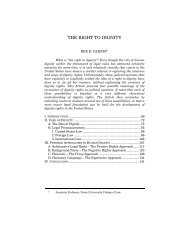A Right to Media? Lorie M. Graham - Columbia Law School
A Right to Media? Lorie M. Graham - Columbia Law School
A Right to Media? Lorie M. Graham - Columbia Law School
You also want an ePaper? Increase the reach of your titles
YUMPU automatically turns print PDFs into web optimized ePapers that Google loves.
506 COLUMBIA HUMAN RIGHTS LAW REVIEW [41:429<br />
advocate for social or economic change, they may not be able <strong>to</strong><br />
significantly combat racial stereotypes promulgated by public or<br />
private entities or fight against discrimination, and they may not be<br />
able <strong>to</strong> respond <strong>to</strong> erroneous misinformation about who they are and<br />
what they value. These are only a few of the troubling implications of<br />
the lack of freedom of expression and right <strong>to</strong> information.<br />
Unfortunately, as discussed above, such are the obstacles<br />
faced by many indigenous peoples precisely because they have been<br />
denied a right <strong>to</strong> media. <strong>Media</strong>, as the most ubiqui<strong>to</strong>us means of<br />
mass communication, is the conduit through which all peoples<br />
exercise the right <strong>to</strong> freedom of expression and right <strong>to</strong> information.<br />
Yet for decades, radio, television, print media, music and all of the<br />
many other forms of media have been dominated by non-indigenous<br />
voices <strong>to</strong> the exclusion of indigenous voices. Furthermore, media has<br />
been utilized by both state and private ac<strong>to</strong>rs <strong>to</strong> promote assimilation<br />
of indigenous peoples with the resulting marginalization of<br />
indigenous communities. This his<strong>to</strong>rical legacy has resulted in<br />
structural and cultural barriers <strong>to</strong> media, which has in turn<br />
undermined other basic rights <strong>to</strong> education, culture, language, selfrepresentation,<br />
and non-discrimination.<br />
Thus the idea of media and rights extends well beyond the<br />
mere ability <strong>to</strong> view indigenous programming or <strong>to</strong> listen <strong>to</strong><br />
indigenous news. The very linguistic and cultural distinctions which<br />
make up an indigenous people are threatened by the denial of their<br />
rights <strong>to</strong> expression and information, which in turn impacts their<br />
ability <strong>to</strong> transmit culture, participate in decision-making processes,<br />
and realize meaningful rights of self-governance. Moreover,<br />
discrimination against indigenous peoples in the media not only<br />
transmits erroneous information, but it circumscribes the public<br />
conversation regarding issues of importance <strong>to</strong> indigenous peoples<br />
and shapes the outcomes of very real life and death struggles for<br />
cultural and economic survival.<br />
From a larger societal standpoint, the recognition of a right<br />
<strong>to</strong> media under international law is a critical first step in the process<br />
of improving relations between indigenous peoples and other<br />
segments of society. By appropriately reflecting the diversity of<br />
indigenous cultures in the media, we can begin <strong>to</strong> reverse centuries<br />
of misinformation, discrimination, and marginalization. It is a<br />
means by which <strong>to</strong> give voice <strong>to</strong> indigenous communities and promote<br />
new voices in the process of public deliberation. Building on the<br />
words of Chief Justice Yazzie of the Navajo Supreme Court, this<br />
expanded discourse will in turn help us <strong>to</strong> better understand each















